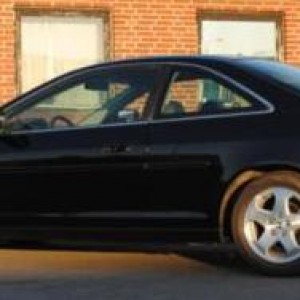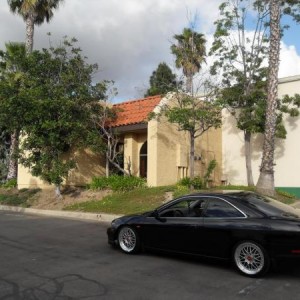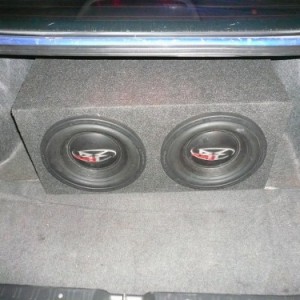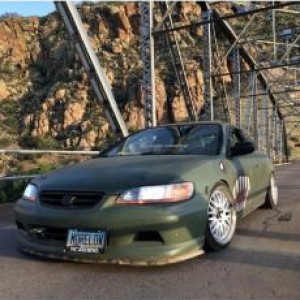AFAccord
Well-Known Member
There seems to be an abundance of interest on the forum of Accord owners wanting to learn how to drive their car’s better, most often in search of that faster ¼ mile time at the drag strip. So here’s my attempt at a ‘Drag Strip How-To’.
All tracks are different. Some have one entrance/exit, and others may have separate entrances for racers and spectators. Most tracks have a varied schedule for different types of racing. Often “Test’n’tune” or “Grudge match” races occur on a week night such as Wednesday or Thursday, and host their “Pro model” or competition matches (bracket racing) on Saturday nights. I find it best to go on the grudge match nights, as these are the nights when anything and everything with wheels can have a chance to make a pass, and there are no classes or qualifying to worry about. It’s just heads up racing. You might race a go-cart, or you might race a 9 second Chevelle. As you enter the track, either at the gate, or at the tech station, you’ll be asked to sign a waiver. This is a printed form that basically signs your life away; in the case that something were to happen to you the track is in no way responsible. Some tracks give “tech cards” to racers at the gate. This card has areas for you to fill in your information, ie. Car make and model, your name, hometown, or anything interesting that the announcer might like to share with the crowd. I use this opportunity to be creative.
Safety:
At some point or another, you and your car will be visually inspected before racing. If the track has a tech station, it will be performed there, if not, it might be done by the guy I like to refer to as the “ringmaster”. This is the gentleman (or lady) who stands between the staging lanes and the waterboxes and directs drivers from the staging lanes to their respective track lanes. Always pay attention to him! The obvious minimum safety requirements are windows that roll up, a seat (durh), working seat-belt, usually long pants, and sometimes a helmet depending on the track. Some tracks may have further precautionary requirements for cars that break a specified speed, or trap faster than a specified E/T (elapsed time). If you think your Accord might run faster than a 13.5 second ¼ mile, by all means, ask about this at the gate so that you don’t lose your entry fee and not be able to race because you lack the necessary equipment. Tracks don’t give refunds.
Entering the track:
So your palms start to sweat, gripping the steering wheel as you turn into the drag strip, knowing that you’re about to put your machine to the test. This is the moment your empty checking account, late nights, and hours of hard work come to a brief (longer for some of us) moment of truth. Will all your work reward you with bragging rights to all your buddies? Or will you go home with the shame that a Dodge Neon just whooped that ***? Or worse yet, could something break on your beloved Accord? But then you relax as you pay the attendant your entry fees and she hands you your tech card, because after all, you just read this ‘Guide to the Drag Strip’, and know exactly what to expect!
Your first stop at this point should be at the “tech station”. This is where an attendant will visually inspect your car for required safety precautions, and assign your car a number, as well as write your number on the windows of the car for identification purposes. Write this number on you tech car before handing it to the attendant. This is how the announcer will know who you are when you stage. This number also distinguishes you on your time slips, which you will receive immediately after your pass.
Ready to Race:
I suggest parking your car and grabbing a spot in the stands near the water box (often just an area with a dip in the asphalt behind the racing lanes, that the track operators keep wet for guys with slicks to clean and ‘losen’ their tires for a burn-out). This gives you the opportunity to see how the ‘tree’ works so there’s no surprises when you get up to race. This is also a time for your car to cool off if you had to drive a considerable distance to the track. Watch at least three cars make their passes. Look to see about where the cars are staging, you may even be able to see the box with holes in it that houses the staging equipment. Also take note of where the track ends. There’s nothing like flying down the track and not knowing whether you’ve passed the finish line or not. Some tracks have it clearly marked, others may not. Take note of how the “ringmaster” calls the cars forward out of the staging lanes, and onto the track. He’ll often just point at the two cars he wants, then signal which way for each of the cars to enter the racing lanes. The ‘tree’ is the stand between the two lanes which holds the lights that tell you when to go. The tree can operate in multiple modes. The most common for test’n’tune days is the “Sportsman’s tree”. In this setup, the three yellow lights and one green light illuminate in succession, exactly .5 seconds apart, in a “3-2-1-Go!” fashion. “.000” would mean you broke through the staging beams exactly on the last yellow light, and .500 seconds later would be the green, thus .500 is considered a perfect reaction. If you go on a standard night when a competition is going on, you’re likely to see a “Pro-tree”. In this case, the three yellow lights illuminate at once, immediately followed by the green, in a “Set-Go!” fashion at .400 seconds apart. Obviously the sportsman’s tree is easier to time correctly.
Staging:
So you’ve got the idea of how the track works, and you’re ready to try your skill? Get in your car, and pull up to the staging lanes. Make sure you’re a/c is OFF. I’ll explain this later. This can be anywhere from two, to ten lanes beside each other. They’re usually numbered, and the announcer will usually make an announcement such as “Cars with slicks, lane one and two. Street cars, lane three and four.” Be sure to pay attention to this before staging, or you could piss off a lot of people around you. You’ll probably have to wait in a line in the staging lanes, as the ringmaster directs cars to do their runs. DO NOT leave your car unattended at this point! When you get towards the front of the lanes, be sure to keep your eyes on the ringmaster incase he points to you. At this point be sure to have your seatbelt on, windows up, and helmet donned if necessary. When you’re directed to your race lane, be prompt, but not rushed. For 95% of the people reading this, you should STAY OUT of the water box. Drive in front of it onto your lane if you’re in the near lane, or swing out and around it if you’re directed to the outer lane. The drivers with higher powered cars will greatly appreciate this! If you run through the water box with your FWD car with street tires, you will pick up water in the treads and take it onto the track. Even if you burn out, you’ll just sling the water onto your fender wells, allowing it to drip back onto your tires and onto the track during your run. This is just as much of a real safety concern as it is a courtesy. A powerful RWD car that runs after you is at high risk of spinning out and losing control on a wet track. As stated earlier, you should not run your a/c before getting ready to stage. This is just another way to introduce water onto the track from the condenser.
The Burn-out:
If you are running true drag radials, you might consider rolling through the water before a burn-out, but this still takes water onto the track from your rear tires. I usually avoid the water box completely unless I’m running all out slicks, in which case it is absolutely necessary to warm the tires with a burn-out. For drag-radials, it’s often necessary to warm the tires before making a pass, but I would do this without rolling through the water box. If you’re using drag-radials, you car is probably plenty of capable of performing a burn-out without wetting the tires. If you’re on street tires, there’s really no reason to do a burn-out. Even with ultra-high performance tires, the tread compound doesn’t very much benefit by being heated. Some individuals might choose to skip the water box, and do a very brief burn-out on street tires just to get any sand or rocks off the tires, but I find this an unnecessary risk of suffering wheel hop. Wheel hop is the number one killer of our cars in racing. The constant loading/unloading of the drive train will snap an axle or CV joint very quickly. On that note, we’ll go on to the launch…
All tracks are different. Some have one entrance/exit, and others may have separate entrances for racers and spectators. Most tracks have a varied schedule for different types of racing. Often “Test’n’tune” or “Grudge match” races occur on a week night such as Wednesday or Thursday, and host their “Pro model” or competition matches (bracket racing) on Saturday nights. I find it best to go on the grudge match nights, as these are the nights when anything and everything with wheels can have a chance to make a pass, and there are no classes or qualifying to worry about. It’s just heads up racing. You might race a go-cart, or you might race a 9 second Chevelle. As you enter the track, either at the gate, or at the tech station, you’ll be asked to sign a waiver. This is a printed form that basically signs your life away; in the case that something were to happen to you the track is in no way responsible. Some tracks give “tech cards” to racers at the gate. This card has areas for you to fill in your information, ie. Car make and model, your name, hometown, or anything interesting that the announcer might like to share with the crowd. I use this opportunity to be creative.
Safety:
At some point or another, you and your car will be visually inspected before racing. If the track has a tech station, it will be performed there, if not, it might be done by the guy I like to refer to as the “ringmaster”. This is the gentleman (or lady) who stands between the staging lanes and the waterboxes and directs drivers from the staging lanes to their respective track lanes. Always pay attention to him! The obvious minimum safety requirements are windows that roll up, a seat (durh), working seat-belt, usually long pants, and sometimes a helmet depending on the track. Some tracks may have further precautionary requirements for cars that break a specified speed, or trap faster than a specified E/T (elapsed time). If you think your Accord might run faster than a 13.5 second ¼ mile, by all means, ask about this at the gate so that you don’t lose your entry fee and not be able to race because you lack the necessary equipment. Tracks don’t give refunds.
Entering the track:
So your palms start to sweat, gripping the steering wheel as you turn into the drag strip, knowing that you’re about to put your machine to the test. This is the moment your empty checking account, late nights, and hours of hard work come to a brief (longer for some of us) moment of truth. Will all your work reward you with bragging rights to all your buddies? Or will you go home with the shame that a Dodge Neon just whooped that ***? Or worse yet, could something break on your beloved Accord? But then you relax as you pay the attendant your entry fees and she hands you your tech card, because after all, you just read this ‘Guide to the Drag Strip’, and know exactly what to expect!

Your first stop at this point should be at the “tech station”. This is where an attendant will visually inspect your car for required safety precautions, and assign your car a number, as well as write your number on the windows of the car for identification purposes. Write this number on you tech car before handing it to the attendant. This is how the announcer will know who you are when you stage. This number also distinguishes you on your time slips, which you will receive immediately after your pass.
Ready to Race:
I suggest parking your car and grabbing a spot in the stands near the water box (often just an area with a dip in the asphalt behind the racing lanes, that the track operators keep wet for guys with slicks to clean and ‘losen’ their tires for a burn-out). This gives you the opportunity to see how the ‘tree’ works so there’s no surprises when you get up to race. This is also a time for your car to cool off if you had to drive a considerable distance to the track. Watch at least three cars make their passes. Look to see about where the cars are staging, you may even be able to see the box with holes in it that houses the staging equipment. Also take note of where the track ends. There’s nothing like flying down the track and not knowing whether you’ve passed the finish line or not. Some tracks have it clearly marked, others may not. Take note of how the “ringmaster” calls the cars forward out of the staging lanes, and onto the track. He’ll often just point at the two cars he wants, then signal which way for each of the cars to enter the racing lanes. The ‘tree’ is the stand between the two lanes which holds the lights that tell you when to go. The tree can operate in multiple modes. The most common for test’n’tune days is the “Sportsman’s tree”. In this setup, the three yellow lights and one green light illuminate in succession, exactly .5 seconds apart, in a “3-2-1-Go!” fashion. “.000” would mean you broke through the staging beams exactly on the last yellow light, and .500 seconds later would be the green, thus .500 is considered a perfect reaction. If you go on a standard night when a competition is going on, you’re likely to see a “Pro-tree”. In this case, the three yellow lights illuminate at once, immediately followed by the green, in a “Set-Go!” fashion at .400 seconds apart. Obviously the sportsman’s tree is easier to time correctly.
Staging:
So you’ve got the idea of how the track works, and you’re ready to try your skill? Get in your car, and pull up to the staging lanes. Make sure you’re a/c is OFF. I’ll explain this later. This can be anywhere from two, to ten lanes beside each other. They’re usually numbered, and the announcer will usually make an announcement such as “Cars with slicks, lane one and two. Street cars, lane three and four.” Be sure to pay attention to this before staging, or you could piss off a lot of people around you. You’ll probably have to wait in a line in the staging lanes, as the ringmaster directs cars to do their runs. DO NOT leave your car unattended at this point! When you get towards the front of the lanes, be sure to keep your eyes on the ringmaster incase he points to you. At this point be sure to have your seatbelt on, windows up, and helmet donned if necessary. When you’re directed to your race lane, be prompt, but not rushed. For 95% of the people reading this, you should STAY OUT of the water box. Drive in front of it onto your lane if you’re in the near lane, or swing out and around it if you’re directed to the outer lane. The drivers with higher powered cars will greatly appreciate this! If you run through the water box with your FWD car with street tires, you will pick up water in the treads and take it onto the track. Even if you burn out, you’ll just sling the water onto your fender wells, allowing it to drip back onto your tires and onto the track during your run. This is just as much of a real safety concern as it is a courtesy. A powerful RWD car that runs after you is at high risk of spinning out and losing control on a wet track. As stated earlier, you should not run your a/c before getting ready to stage. This is just another way to introduce water onto the track from the condenser.
The Burn-out:
If you are running true drag radials, you might consider rolling through the water before a burn-out, but this still takes water onto the track from your rear tires. I usually avoid the water box completely unless I’m running all out slicks, in which case it is absolutely necessary to warm the tires with a burn-out. For drag-radials, it’s often necessary to warm the tires before making a pass, but I would do this without rolling through the water box. If you’re using drag-radials, you car is probably plenty of capable of performing a burn-out without wetting the tires. If you’re on street tires, there’s really no reason to do a burn-out. Even with ultra-high performance tires, the tread compound doesn’t very much benefit by being heated. Some individuals might choose to skip the water box, and do a very brief burn-out on street tires just to get any sand or rocks off the tires, but I find this an unnecessary risk of suffering wheel hop. Wheel hop is the number one killer of our cars in racing. The constant loading/unloading of the drive train will snap an axle or CV joint very quickly. On that note, we’ll go on to the launch…
Last edited:









